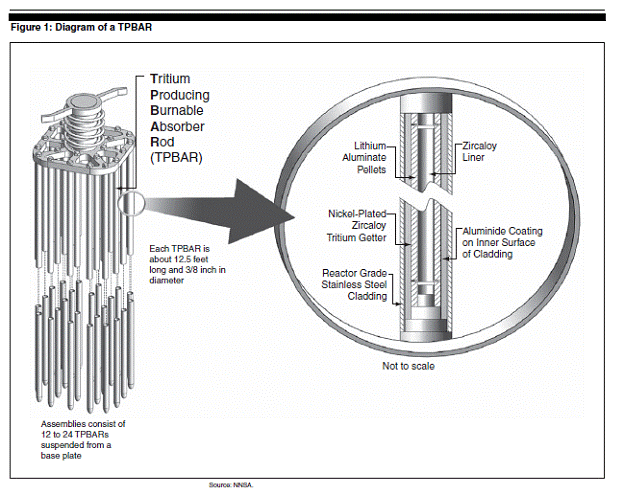Guest contribution by Robert Alvarez
In a recent report to the U.S. House Armed Services Committee, the Government Accountability Office concluded that the National Nuclear Security Agency (NNSA) in the Energy department is "unable to overcome technical challenges" to producing tritium (H3) in a commercial power reactor for the U.S. nuclear arsenal. As a result the ability to provide new supplies of this radioactive isotope used to enhance the explosive power of nuclear weapons "is in doubt."
Because its half-life of 12.3 years, tritium has to be periodically replenished in weapons. From 1954 to 1988, tritium was produced in government reactors, which were closed for safety reasons. In 1993, GAO concluded that tritium supplies from nuclear arms reductions was sufficient to meet warhead needs until 2012. After that GAO concluded that a new tritium production capability would be needed.
In response, the Department of Energy decided in the late 1990's to produce new supplies in a commercial power reactor, using new tritium-producing burnable absorber rods (TBARs). They contain lithium-aluminate pellets lined with zirconium, and are clad into long pencil-shaped, stainless steel rods. Tritium is produced when the atoms of lithium-6 absorbs neutrons in the reactor core.

However, the rods cannot fully contain the tritium, which is permeating into the reactor cooling system, approaching safety limits set by the Nuclear Regulatory Commission (NRC). To meet projected tritium requirements, additional TVA reactors may be required (NNSA indicated that it is planning to use two other TVA reactors - Sequoyah 1 and 2). NNSA has not yet coordinated this with the NRC, which must approve any reactor changes.
A reserve stockpile of tritium has yet to be tapped and its size remains classified. Nor is it clear how much more tritium is expected to come from the pending START II arms reduction agreement with Russia, now before the U.S. Senate. Nonetheless, GAO remains concerned. "If NNSA takes longer than expected to increase tritium production, even reserve quantities may be insufficient to meet requirements for an extended period of time."
Tritium production alternatives include building a new government production reactor or the development of linear accelerators. Both are likely cost billions of dollars and take several years to bring on line.
However, expanding the production of tritium for nuclear weapons in commercial nuclear power plants further undermines the long-standing barrier between military and civilian nuclear energy applications - a key element of U.S. nuclear non-proliferation policy.
This is a situation where public debate and greater transparency by the U.S. nuclear weapons program is sorely needed.